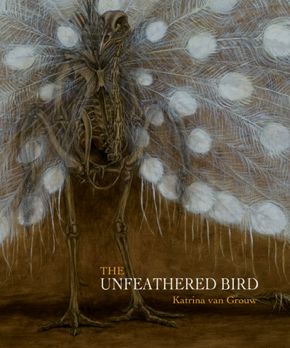The Unfeathered Bird by Katrina van Grouw is now available in bookstores (left). Published by Princeton University Press, the 304-page book is filled with more than 300 illustrations – not birds in all their colourful glory but in their unfeathered glory. These illustrations are devoid of feathers. Many show muscles while others the skeletal systems. All were meticulously drawn from actual specimens in order to maintain scientific accuracy. After all, author Katrina is a renowned artist-taxidermist and she takes her work seriously.
Yes, the book looks beyond the plumage or literally under it to reveal the anatomy of birds. At first glance it may appear dry due to the monochromatic colours. But delve into the text and you will find a goldmine of information, especially on forms and functions.
Take the collection of heads that displays a wide range of bill types. The hooked bill of vultures and owls is adapted for tearing flesh. The short and crooked bill of parrots makes it an efficient nutcracker. The dagger-like bill of kingfishers is flattened at the sides in insectivorous forest species while in fish-eaters it is flattened horizontally. Herons catch prey by its forward thrusting action and their similar shaped bill is serrated along the edges, the better to hold on to a slippery fish. The large, curved bill of hornbills has mandibles that meet at the tips, turning it into a precision instrument for picking up the tiniest of objects. At the same time the mandibles serve as an efficient nutcracker with the presence of a wide gap along their length.
Of all the groups, the finches show the most diversity of bill types, all adapted for eating various forms of seeds – fine-pointed bill to prise out small seeds, crossbills with overlapping mandibles used as levers to force open pine scales so that the tongue can get at the seeds, and of course Darwin finches of the Galapagos Islands that show seamless gradation of every bill shape to feed on different seeds types and insects.
Besides bills, feet are also well covered, as seen in the strongly hooked talons of raptors and owls for catching and grasping prey. The toes of woodpeckers, armed with curved claws, allow for climbing and clinging onto the vertical surface of tree trunks. Of particular interest is the serrated or pectinated inner edge of the middle claw of herons, cormorants (above) and darters, used to remove fish slime from their plumage LINK. In swifts the tiny feet are armed with needle sharp claws, adapted for gripping hard surfaces and not for perching.
I am particularly intrigued by the display of many of the skeletal systems – they are in real life positions, allowing one to visualise how the live birds covered in their colourful plumage, look. The illustration of the Great Spotted Woodpecker (Dendrocopos major), perched on a tree trunk in all its skeletal glory provides new perspective of how the bird adapts to its environment (below right). Note that the final tail vertebra, the pygostyle or tailbone, is enormous, with broadened underside to allow for the attachment of muscles that help pull the tail feathers against the tree to prevent the body from tilting backwards. The Banded Woodpecker (Chrysophlegma miniaceus) on its left by Johnny Wee, complete with its colourful plumage, allows for a comparison.
The author of the book is an artist in her own right. Although lacking in formal scientific training, Katrina’s skills in specimen preparation and taxidermy as well as her ornithological knowledge landed her a curatorial position with the ornithological collection at the London’s Natural History Museum. She left her post at the museum in 2010 to complete this book.
Birdwatchers have always focused on the bird’s plumage in order to identify the species. Rightly so, as otherwise how else can they tick on their checklists or generate their ubiquitous lists of species. But they should not “tick and list” at the expense of documenting other aspects like bird behaviour. After all, they are already in the field observing birds and noting down their behaviour does not involve any extra effort. Since the launching of this website in 2005, many birdwatchers have been persuaded to see beyond the plumage. The success of our website bears testimony to this fact.
The next move is to challenge birdwatchers to upgrade their craft – spicing up birdwatching with a little more science – in this case, associating forms with functions. This is where The Unfeathered Bird can play a role. After all, how many birdwatchers can visualise what goes on below the plumage, something they do not see unless they are involved in skinning specimens for the museum, and how many have the opportunity do so?
YC Wee
Singapore
March 2013



![cormorant_146 [KatrinaGrouw]](https://besgroup.org/wp-content/uploads/cormorant_146-KatrinaGrouw1.jpg)
![Wd'pkerBd [JWee]](https://besgroup.org/wp-content/uploads/WdpkerBd-JWee.jpg)
![Wd'pkerGreatSpotted [KatrinaGrouw]](https://besgroup.org/wp-content/uploads/WdpkerGreatSpotted-KatrinaGrouw.jpg)







2 Responses